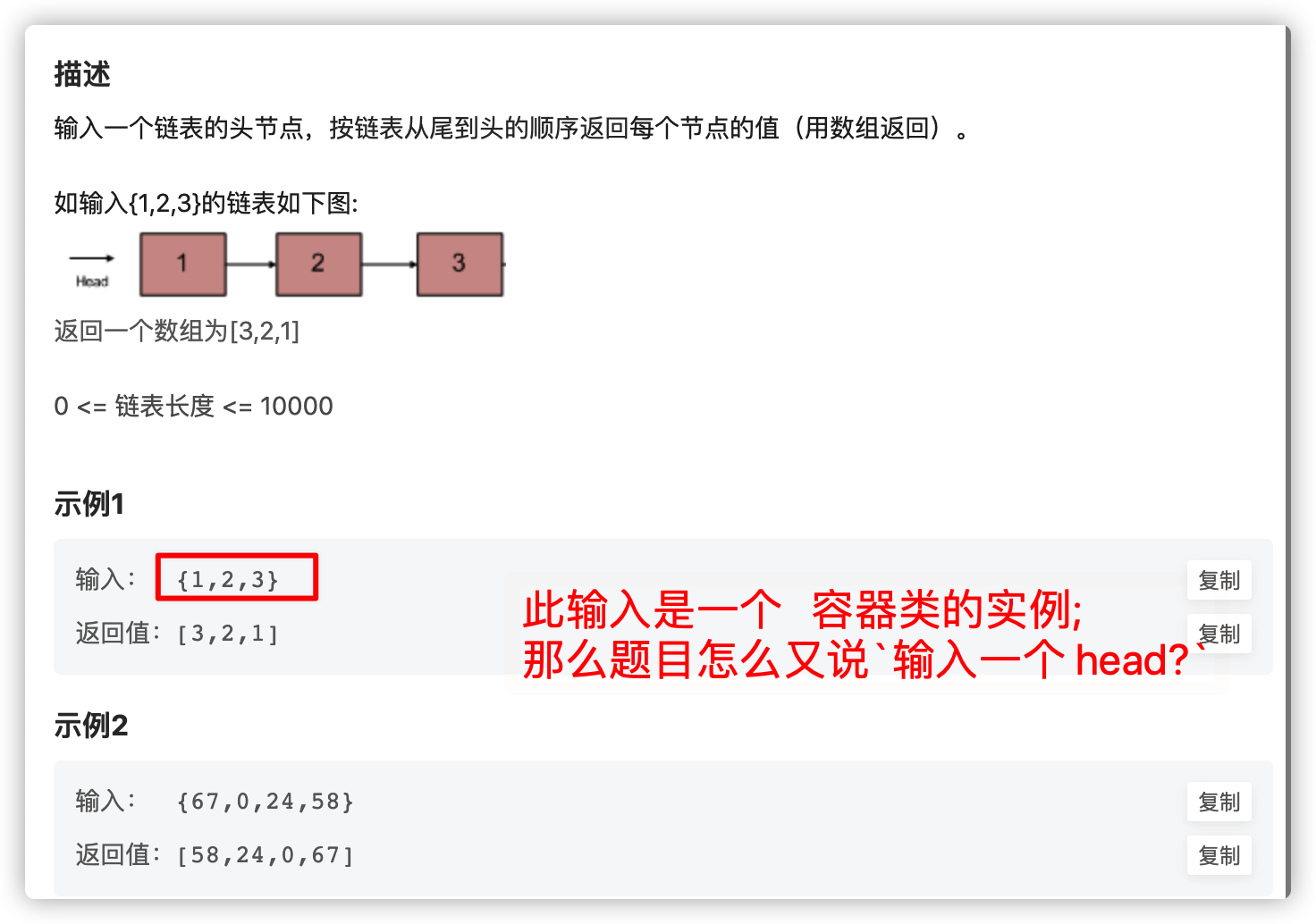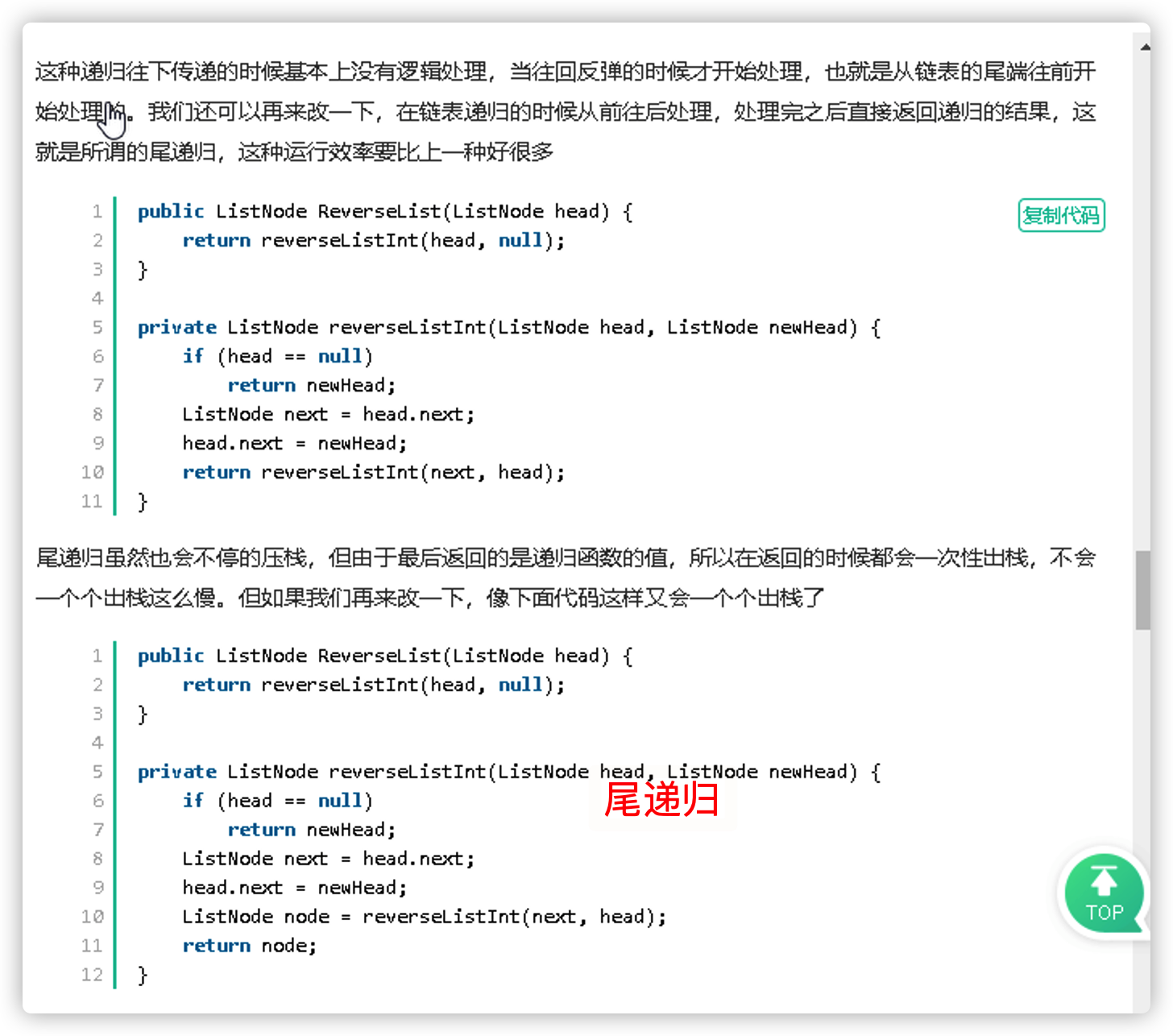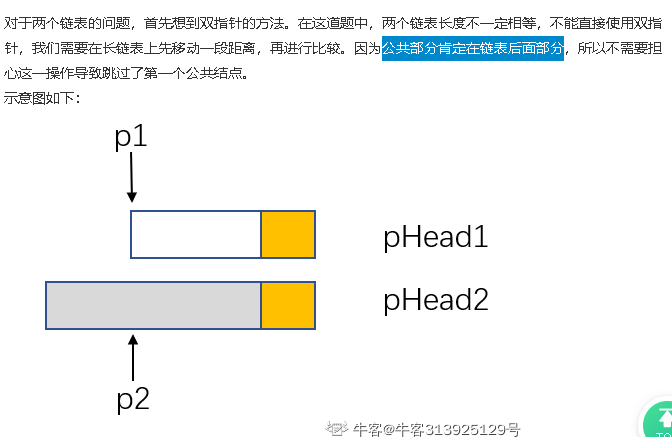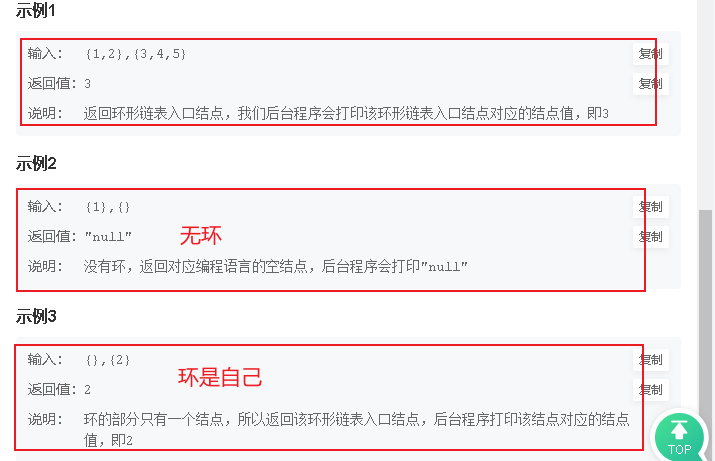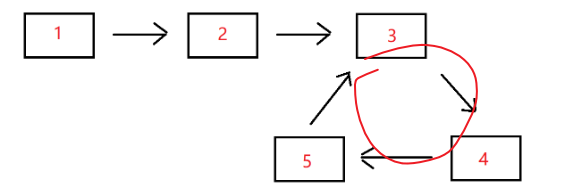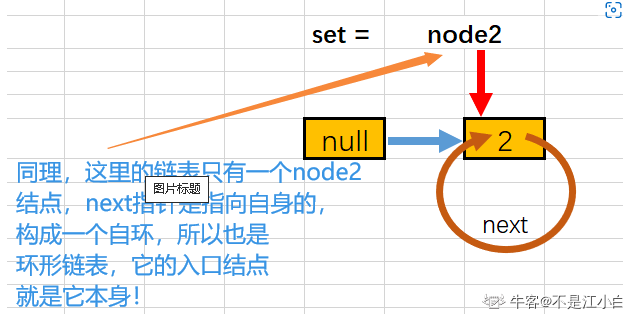JZ6 从尾到头打印链表
我的解法

import java.util.*;/*** public class ListNode {* int val;* ListNode next = null;** ListNode(int val) {* this.val = val;* }* }**/import java.util.ArrayList;public class Solution {public ArrayList<Integer> printListFromTailToHead(ListNode listNode) {ArrayList<Integer> list = new ArrayList();while( listNode!=null){list.add(listNode.val);listNode = listNode.next;}// 感觉此时的 ListNode.next != null 也不是很有必要;while(listNode !=null && listNode.next!=null){list.add(listNode.val);listNode = listNode.next;}ArrayList<Integer> listReverse = new ArrayList();while(list.listIterator().hasPrevious()){listReverse.add(list.listIterator().previous());}// listReverse.toArray();return listReverse;}}
难点: 自己 不知道 util 下有哪些工具类, 工具类的方法名字也不记得 总体思路清晰:
1.根据 head 去遍历所有,放入一个容器里,
- 遍历使用
.next更新 head, 往容器里存入的是什么,是 节点类实例?还是节点类的值域;- 倒序遍历使用了 ListIterator及 previous ,根据 2 确定
- 是否需要转换为java数组;
困惑点:
- 题目写的输入 是 {1,2,3}, 这肯定不是一个 head, 而是一个容器对象实例;
- 题目写的输出是[1,2,3] , 那么提示的 printListFromTailToHead 的返回值为什么不是 数组呀? 而是一个容器!
- 还是说, 输入输出是测试用例?我不太懂
网友答案
// 更加容易理解一些;import java.util.*;/*** public class ListNode {* int val;* ListNode next = null;** ListNode(int val) {* this.val = val;* }* }**/import java.util.ArrayList;import java.util.Stack;public class Solution {ArrayList<Integer> list = new ArrayList();public ArrayList<Integer> printListFromTailToHead(ListNode listNode) {if(listNode != null) {printListFromTailToHead(listNode.next);list.add(listNode.val); // add最后一个, 倒数第二个;...正数第一个;}return list;}}
import java.util.Collections;import java.util.ArrayList;public class Solution {public ArrayList<Integer> printListFromTailToHead(ListNode listNode) {ArrayList<Integer> ans = new ArrayList<>();printListFromTailToHeadCore(ans,listNode);return ans;}private void printListFromTailToHeadCore(ArrayList<Integer> ans, ListNode listNode) {if (listNode == null){return;}printListFromTailToHeadCore(ans,listNode.next);ans.add(listNode.val);}}
/***1.递归*2.借用栈*3.头插法,每个元素都往前插入add(index,value)用法 小心些;https://blog.csdn.net/qq_27093465/article/details/55211722**/public class Solution {public ArrayList<Integer> printListFromTailToHead(ListNode listNode) {ArrayList<Integer> array = new ArrayList<Integer>();while(listNode != null){array.add(0,listNode.val);listNode = listNode.next;}return array;}}// ?// ArrayList<Integer> list = new ArrayList<>();// while(listNode != null){// list.add(listNode.val);// listNode = listNode.next;// }// int i = 0;// int j = list.size() - 1;// while(i < j){// int tmp = list.get(i);// list.set(i,list.get(j));// list.set(j,tmp);// i++;// j--;// }// return list;// 借用栈// ArrayList<Integer> list = new ArrayList<>();// Stack <Integer> stack = new Stack<>();// if(listNode == null){// return list;// }// while(listNode != null){// stack.push(listNode.val);// listNode = listNode.next;// }// while(!stack.empty()){// list.add(stack.pop());// }// return list;
/*** public class ListNode {* int val;* ListNode next = null;** ListNode(int val) {* this.val = val;* }* }**/import java.util.*;public class Solution {/*// 方法一:先进后出,我们可以想到栈public ArrayList<Integer> printListFromTailToHead(ListNode listNode) {//用来存储链表中节点的值。Stack<Integer> reverse = new Stack<>();while(listNode != null){reverse.push(listNode.val);listNode = listNode.next;}//创建的题目要求的数据类型来存储反向的节点值。ArrayList<Integer> result = new ArrayList<>();while(!reverse.isEmpty()){//将值从栈中弹出,并添加到ArrayList中result.add(reverse.pop());}return result;}*//*//方法一:递归ArrayList<Integer> arr = new ArrayList();public ArrayList<Integer> printListFromTailToHead(ListNode listNode) {if(listNode != null){printListFromTailToHead(listNode.next);arr.add(listNode.val);}return arr;}*//*// 方法二:使用ArrayList 中有个方法是 add(index,value)public ArrayList<Integer> printListFromTailToHead(ListNode listNode) {ArrayList<Integer> list = new ArrayList<>();ListNode tmp = listNode;while(tmp!=null){list.add(0,tmp.val);tmp = tmp.next;}return list;}*/// 链表反转法// 时间复杂度: O(n)// 空间复杂度: O(n)public ArrayList<Integer> printListFromTailToHead(ListNode listNode) {ArrayList<Integer> vals = new ArrayList<>();ListNode pre = null, cur = listNode, next;// 反转链表while (cur != null) {next = cur.next;cur.next = pre;pre = cur;cur = next;}// 添加到vals中cur = pre;while (cur != null) {vals.add(cur.val);System.out.println(cur.val);cur = cur.next;}return vals;}}
public ArrayList<Integer> printListFromTailToHead(ListNode listNode) {ListNode l=listNode;ArrayList<Integer> arrayList=new ArrayList<>();if(listNode==null) return arrayList;Stack<Integer> stack=new Stack<>();// 先进入 在后面;while(l.next!=null){stack.push(l.val);l=l.next;}stack.push(l.val);while (!stack.empty()){arrayList.add(stack.pop());}return arrayList;}public ArrayList<Integer> printListFromTailToHead(ListNode listNode) {// 建立一个listArrayList<Integer> list = new ArrayList();Stack<Integer> stack = new Stack();// 先入栈, 是元素的值while(listNode != null){stack.push(listNode.val);listNode = listNode.next;}// 出栈并加入listwhile(!stack.isEmpty()){list.add(stack.pop());}return list;}
JZ24 反转链表
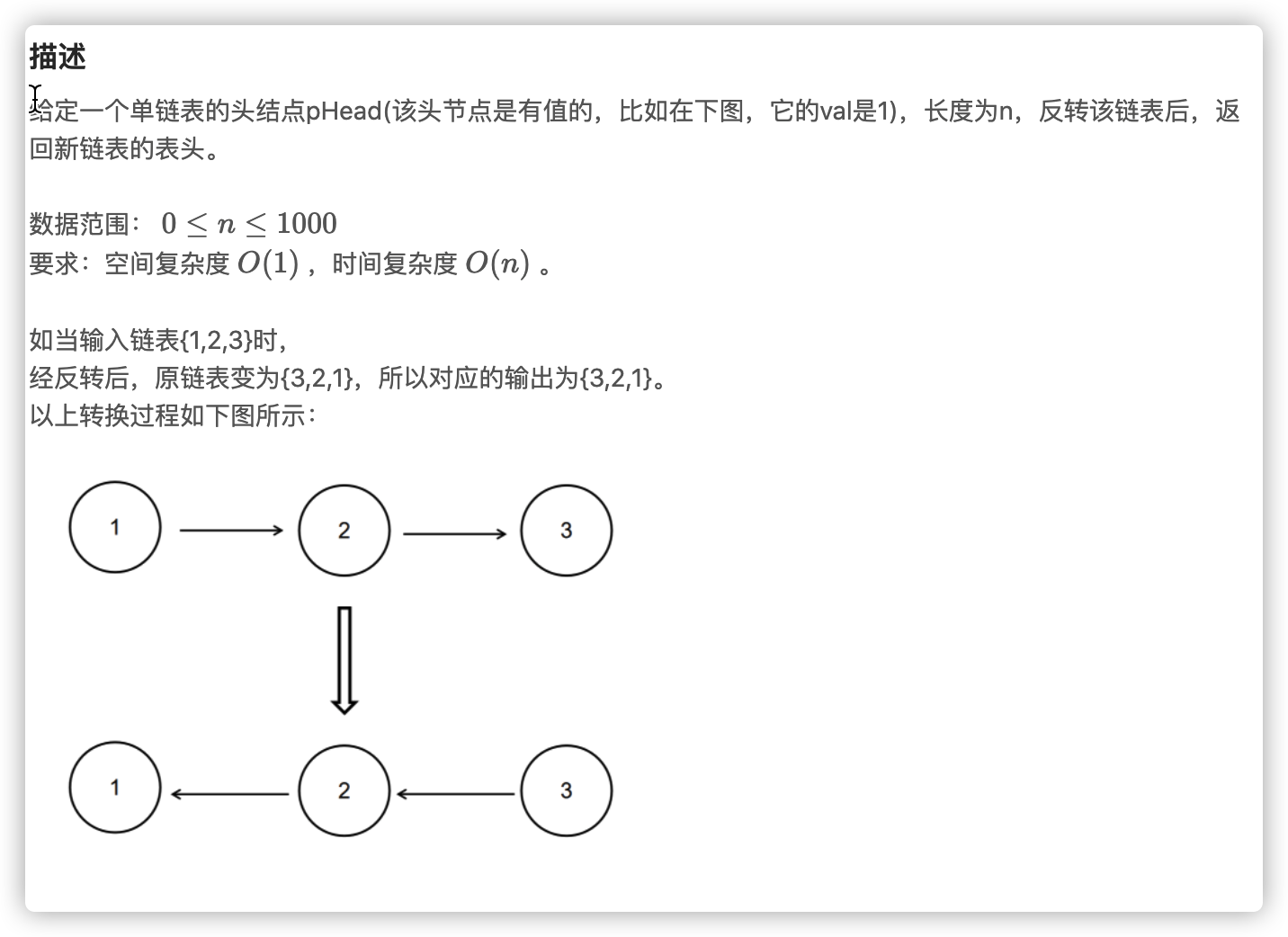
我的答案
尽管描述的测试用例让人误会,还是根据代码区提示即可
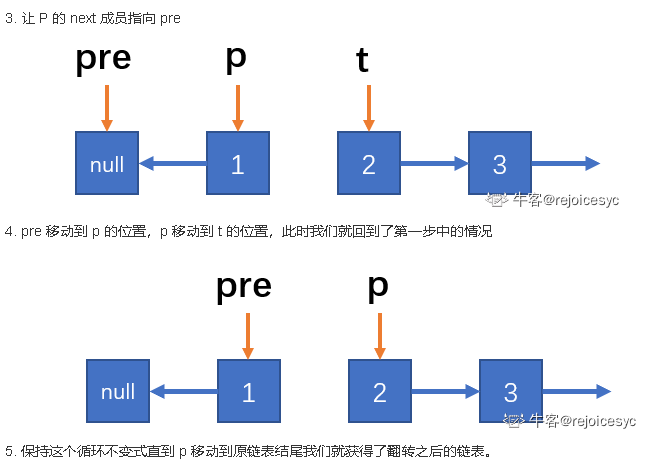
import java.util.*;/*public class ListNode {int val;ListNode next = null;ListNode(int val) {this.val = val;}}*/public class Solution {public ListNode ReverseList(ListNode head) {if(head == null) return null;if (head.next == null) return head;ListNode cur = head;ListNode pre = null;//while(cur!=null){ListNode temp = cur.next;cur.next = pre;// 在更改引用之前, 存储后一个节点pre = cur ; // 事先存储当前要调转节点的前一个节点;cur = temp;}return pre;}}
其他
- 栈
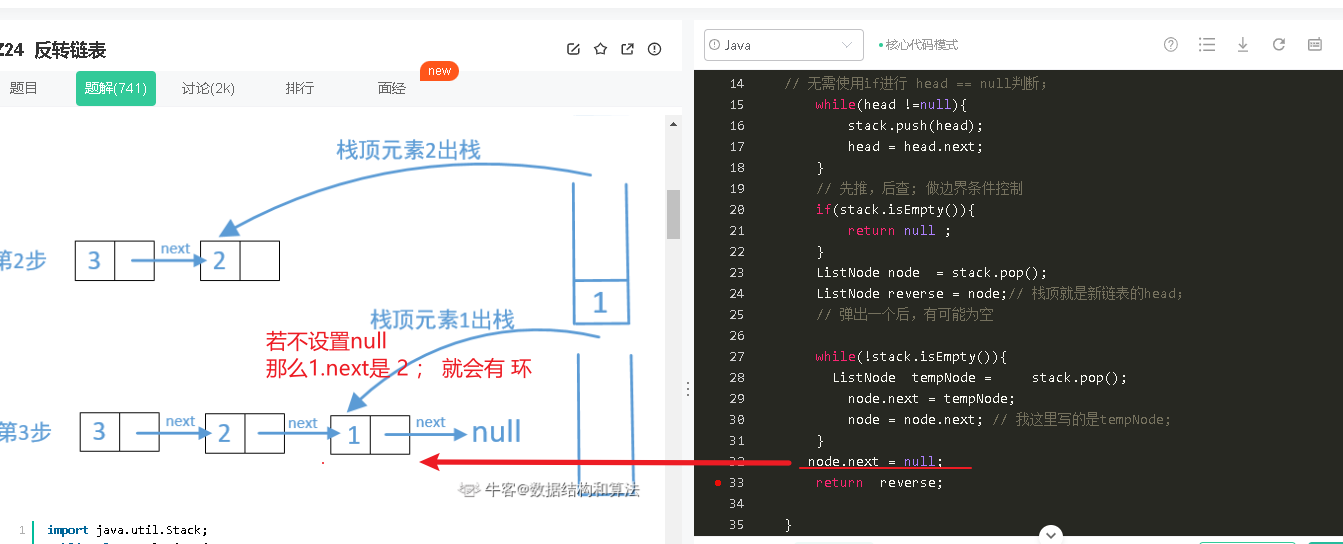
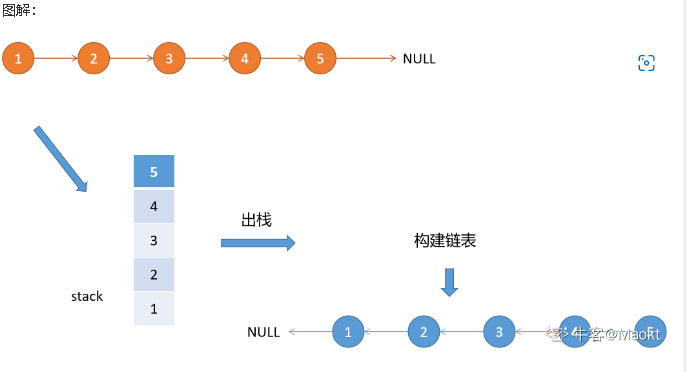
import java.util.*;/*public class ListNode {int val;ListNode next = null;ListNode(int val) {this.val = val;}}*/public class Solution {public ListNode ReverseList(ListNode head) {Stack<ListNode> stack = new Stack<>();// 无需使用if进行 head == null判断;while(head !=null){stack.push(head);head = head.next;}// 先推,后查; 做边界条件控制if(stack.isEmpty()){return null ;}ListNode node = stack.pop();ListNode reverse = node;// 栈顶就是新链表的head;// 弹出一个后,有可能为空while(!stack.isEmpty()){ListNode tempNode = stack.pop();node.next = tempNode;// 写node.next更加符合 都是链表的序列元素;node = node.next // 我这里写的是tempNode;}node.next = null;return reverse;}}
public ListNode ReverseList(ListNode head) {if(head != null) return head;// 新链表头节点ListNode newHead = null ;while(head != null){// 原链表 当前的下一个节点ListNode tempNode = head.next;// 这也是双向链表的实现方式;// 就是把 新的链表(头为newHead) 挂载到当前(head)的next(后面)即可;head.next = newHead;newHead = head;head = tempNode;}return newHead;}
:::info
public ListNode reverseList(参数0) {
if (终止条件)
return;
逻辑处理(可能有,也可能没有,具体问题具体分析)//递归调用<br /> ListNode reverse = reverseList(参数1);逻辑处理(可能有,也可能没有,具体问题具体分析)<br />}
:::
public ListNode ReverseList(ListNode head) {// 退出条件if(head == null || head.next == null){return head;}// 逻辑处理ListNode next = head.next;//从当前节点的下一个节点开始递归调用ListNode reverse = ReverseList(next);// reverse是反转之后的链表的头节点,// 反转完之后, next是 链表的尾结点;// 将当前节点head, 挂载到 next之后即可.next.next = head; // next 是当前节点的环.head.next = null ; // 不这么做, 就会构成环.return reverse;}
public ListNode ReverseList(ListNode head) {if (head == null || head.next == null)return head;ListNode reverse = ReverseList(head.next);head.next.next = head;head.next = null;return reverse;}使用递归函数,一直递归到链表的最后一个结点,该结点就是反转后的头结点,记作 ans此后,每次函数在返回的过程中,让当前结点的下一个结点的 next 指针指向当前节点。同时让当前结点的 next 指针指向NULL ,从而实现从链表尾部开始的局部反转当递归函数全部出栈后,链表反转完成。时间复杂度:O(N),其中 N 是链表的长度。需要对链表的每个节点进行反转操作。空间复杂度:O(N),其中 N 是链表的长度。空间复杂度主要取决于递归调用的栈空间,最多为 N 层
合并排序链表
:::info
当两个链表为空时,返回空链表
当两个链表均不为空,谁的当前元素小,将谁放入新的链表中,然后指针右移
当最后只有一个非空链表时,直接放在新链表的右侧
:::
import java.util.*;/*public class ListNode {int val;ListNode next = null;ListNode(int val) {this.val = val;}}*/public class Solution {public ListNode Merge(ListNode list1,ListNode list2) {if(list1 == null && list2 == null){return null;}//其他情况,则// 定义一个新的ListNode;ListNode myList = new ListNode(0); // 即将被返回的 头结点ListNode now = myList;while(list1 !=null && list2 !=null){int key; // 临时存储区if( list1.val <= list2.val){key = list1.val;list1 = list1.next;}else{key = list2.val;list2 = list2.next;}// 把较小的值封装起来, 准备给到新的链表;ListNode node = new ListNode(key);now.next = node;now = now.next;}// 只要List1 和List2 有一个为null;if(list1 != null ) now.next = list1;if(list2 != null) now.next = list2;return myList.next; // myList是一个无用的领头;}
链表公共节点
- 快慢指针
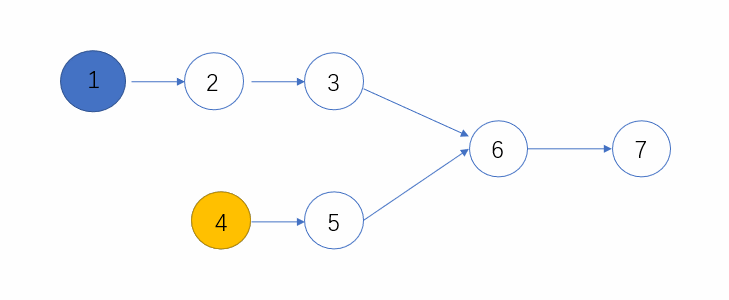
import java.util.*;/*public class ListNode {int val;ListNode next = null;ListNode(int val) {this.val = val;}}*/public class Solution {public ListNode FindFirstCommonNode(ListNode pHead1, ListNode pHead2) {ListNode l1 = pHead1;ListNode l2 = pHead2;while(l1 != l2){// 同样长度,同样速度;那么 只要有相交,就一定会遇到.l1 = (l1 ==null)?pHead2:l1.next;l2 = (l2==null)?pHead1:l2.next; // 当l2 ==null时, 转向pHead1;}// 若l1 == l2 == null; 也算是一种相遇把.return l1;// return l2;}}
时间复杂度:O(m+n)。链表1和链表2的长度之和。
空间复杂度:O(1)。常数的空间。
- 集合set
先把第一个链表的节点全部存放到集合set中,然后遍历第二个链表的每一个节点,判断在集合set中是否存在,如果存在就直接返回这个存在的结点。如果遍历完了,在集合set中还没找到,说明他们没有相交,直接返回null即可
public ListNode FindFirstCommonNode(ListNode pHead1, ListNode pHead2) {HashSet<ListNode> set = new HashSet<ListNode>();// 将List1 全部加入set里;while(pHead1!=null){set.add(pHead1);pHead1 = pHead1.next;}while(pHead2 != null){// 若set里面含有pHead2// 必定是第一个公共节点if(set.contains(pHead2)){return pHead2;}pHead2 = pHead2.next;}// 若集合set不包含链表2的任意一个节点, 说明节点, 直接返回null;return null;}
时间复杂度O(M+N):M, N分别表示 pHead1, pHead2的链表长度,最差情况下需要遍历完两个链表
空间复杂度O(M):需要额外集合空间存储 pHead1 结点
- 统计两个链表的长度
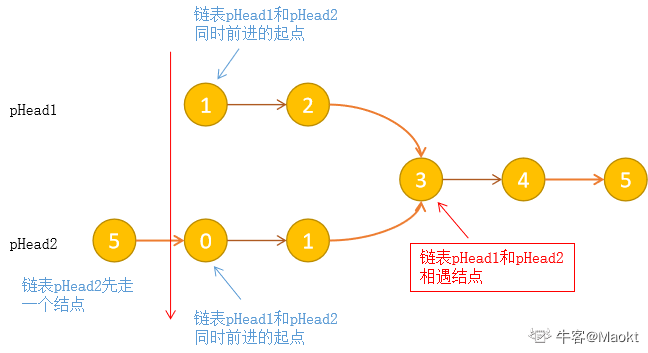
在仅仅遍历一次的情况下, 多余的长度的那部分, 是不可能成为公共区域的节点的.
import java.util.*;/*public class ListNode {int val;ListNode next = null;ListNode(int val) {this.val = val;}}*/public class Solution {public ListNode FindFirstCommonNode(ListNode pHead1, ListNode pHead2) {int lenA =length(pHead1);int lenB = length(pHead2);while(lenA != lenB){if(lenA>lenB){pHead1 = pHead1.next;lenA--;}else{pHead2 = pHead2.next;lenB--;}}// 必定lenA == lenB;while(pHead1 != pHead2){// 引用类型; 指向同一个节点(对象)pHead1 = pHead1.next;pHead2 = pHead2.next;}// 一定相等了 pHead1 == pHead2 ;//1. 都为null// 2. 公共节点return pHead1;}private int length(ListNode node){int length = 0 ;//不可使用iterator,那是容器的迭代器; 当前是一个容器里面的节点;while(node != null){node = node.next;length++;}return length;}}
- 链表公共部分
链表中环的入口节点
HashSet
首先这题要我们找链表的环入口结点,最常规易懂的解法就是遍历整个链表结点,然后用哈希表来存储已访问过的结点,最后进行对比。 若该结点已存在哈希表中,则代表该结点是我们要找的环形链表的入口结点;否则把结点添加到哈希表中,继续往下遍历。
public ListNode EntryNodeOfLoop(ListNode pHead) {HashSet<ListNode> set = new HashSet<ListNode>();while(pHead != null){// 一定要先判断pHead是否已经被set包含了;if(set.contains(pHead)){return pHead;}// pHead必定是不重复的.set.add(pHead);pHead = pHead.next;}}时间复杂度:O(n),需要将链表的所有结点遍历一遍,时间复杂度为O(n);空间复杂度:O(n),需要额外的n空间的hashset来存储结点。
快慢指针
public ListNode EntryNodeOfLoop(ListNode pHead) {if(pHead ==null){return pHead;}ListNode slow = pHead;ListNode fast = pHead;while( fast != null && fast.next != null){fast = fast.next.next;slow = slow.next;// 记录下 快慢指针 第一次相遇的节点if(slow == fast) break;}// 快指针指向null,则无环if(fast == null || fast.next == null){return null;}fast = pHead; // 将快指针拎回头while( fast != slow){fast = fast.next;slow = slow.next; // 起点 和 第一次相遇的节点 以相同速度出发, 相遇即为入口}return fast;}}时间复杂度:O(n),需要将链表的所有结点遍历一遍,时间复杂度为O(n);空间复杂度:O(1),需要额外两个快慢指针来遍历结点。时间复杂度:O(n) (其中n为链表中节点的数目,快慢指针走过的距离都不会超过链表的长度)空间复杂度:O(1) (双指针使用常数大小的额外空间)
无环
有环
结论证明
:::info
1、设置快慢指针,假如有环,他们最后一定相遇。
2、两个指针分别从链表头和相遇点继续出发,每次走一步,最后一定相遇与环入口。
:::

倒数第k个节点
快慢指针
:::info
起始先让快指针 fast 先走 步,此时 fast 和 slow 之间距离为
,之后让 fast 和 slow 指针一起走(始终维持相对距离为
),当 fast 到达链表尾部,slow 即停在倒数第
个节点处。
:::
public class Solution {/**快慢指针有 两倍速度, 有 先k步*/public ListNode FindKthToTail (ListNode pHead, int k) {// write code hereListNode fast = pHead ;ListNode slow = pHead;int count =1 ;while(count <= k){// 快指针先走k步,若发现走着走着fast为null;说明k大于链表长度;if(fast == null){return null;}// if 判断必须放在最前面;count++;fast = fast.next;}// 双指针同时走while(fast != null){fast = fast.next;slow =slow.next;}return slow;}}时间复杂度:O(N)空间复杂度: O(1)
反转链表+头插法
import java.util.*;/** public class ListNode {* int val;* ListNode next = null;* public ListNode(int val) {* this.val = val;* }* }*/public class Solution {/**快慢指针有 两倍速度, 有 先k步*/public ListNode FindKthToTail (ListNode pHead, int k) {ListNode newHead = null;ListNode cur = pHead;int n = 0 ;while(cur != null){// 保存原链下一个ListNode temp = cur.next ;// 反转指向cur.next = newHead;// 将新链表元素更新为当前原链表的节点newHead = cur ;// 移动旧链表元素到 旧链表的下一个;cur = temp;// 遍历个数+1;n++;} // 跳出循环后, newHead将会是 新链表的头结点ListNode kHead = null ;ListNode p = newHead; // 从头结点移动, 头插法int count = 1;if(n < k){ // 无法等于// 链表长度不足, 就没有倒数第k个;return null;}while(count<=k){ListNode temp = p.next;p.next = kHead;kHead = p;p = temp;count++;}return kHead; //KHead是 头插法产生链表的头结点;}}
堆栈
public ListNode FindKthToTail (ListNode pHead, int k) {// 边界条件判断;if(pHead == null || k == 0 ){return null;}//Stack<ListNode> stack = new Stack<>();while(pHead != null){stack.push(pHead);pHead = pHead.next;}// 观察栈的长度 是否小于kif(stack.size() < k){return null;}//弹栈ListNode newHead = stack.pop();// 只要第k个元素; 因为在 while()之前 已经弹栈一次了.while(--k > 0 ){newHead = stack.pop();}return newHead;}
删除链表中重复节点
迭代
public ListNode deleteDuplication(ListNode pHead) {ListNode dummy = new ListNode(-1); //新建一个虚拟节点, 其数据域不是很重要ListNode tail = dummy;while(pHead != null){// 进入循环迭代// 尾结点 或 不同值,才会添加到新的链表;if(pHead.next == null || pHead.next.val!=pHead.val){tail.next = pHead;tail = pHead;}// 若出现 值相同,就持续移动到最后一位;while(pHead.next != null && pHead.val == pHead.next.val){pHead = pHead.next;}// 跳出连续相同的一段, 又向后移动了一位, 因为重复元素不保留;pHead = pHead.next;}tail.next = null;return dummy.next; // dummu是虚假de,dummy.next才是第一个真的;}
递归

拓展
删除链表节点
我的代码
public ListNode deleteNode (ListNode head, int val) {// 传入为空;if(head == null || head.next == null){return null;}ListNode newHead = head;// 迭代整个链表while(head != null){if(head.val == val){head.next = head.next.next;}}return newHead;}
:::info
public ListNode deleteDuplication(ListNode pHead) {
ListNode dummyNode = new ListNode(-1);
ListNode tail = dummyNode;
if(pHead == null){
return null;
}
while( pHead != null){
// 1. 当前与下一个节点值不等 ; pHead.next == null到达末尾, 不存在下一个节点了;
if( pHead.next == null || pHead.val != pHead.next.val ){
// 拼接到 虚拟节点尾部
tail.next = pHead;
// 更新tail
tail = pHead;
}
// 只要相等就一直处理;
while(pHead.next != null && pHead.val == pHead.next.val){
pHead = pHead.next;
// 没有事先保存好下一个节点的使用
// pHead = pHead.next;
// pHead.next = pHead;
}
pHead = pHead.next;
}
// 为了删除那个重复的唯一项
tail.next = null;
return dummyNode.next;
}
:::
网友解法
public ListNode deleteNode (ListNode head, int val) {if(head == null) return null;// 虚拟一个头结点ListNode dummyHead = new ListNode(-1);dummyHead.next = head; // 人为添加一个节点;ListNode pre = dummyHead ;while(head != null){// 当发现val相等if(head.val == val){break;}//更新双指针迭代;pre = head ;head = head.next;}// 结束上述循环 ,1 . break, 2. head == nullif(head == null) return dummyHead.next; // 未找到需要删除值;pre.next = head.next; // 跳过 值相等的那个节点;return dummyHead.next;//}
